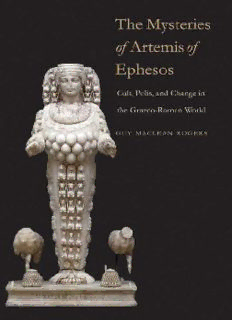
The Mysteries of Artemis of Ephesos: Cult, Polis, and Change in the Graeco-Roman World PDF
Preview The Mysteries of Artemis of Ephesos: Cult, Polis, and Change in the Graeco-Roman World
THE MYSTERIES OF ARTEMIS OF EPHESOS SYNKRISIS Comparative Approaches to Early Christianity in Greco-Roman Culture SERIES EDITORS Dale B. Martin (Yale University) and L. L. Welborn (Fordham University) Synkrisis is a project that invites scholars of Early Christianity and the Greco- Roman world to collaborate toward the goal of rigorous comparison. Each vol- ume in the series provides immersion in an aspect of Greco- Roman culture, so as to make possible a comparison of the controlling logics that emerge from the discourses of Greco- Roman and early Christian writers. In contrast to older “history of religions” approaches, which looked for similarities between reli- gions in order to posit relations of influence and dependence, Synkrisis em- braces a fuller conception of the complexities of culture, viewing Greco- Roman religions and early Christianity as members of a comparative class. The differ- ential comparisons promoted by Synkrisis may serve to refine and correct the theoretical and historical models employed by scholars who seek to understand and interpret the Greco- Roman world. With its allusion to the rhetorical exer- cises of the Greco- Roman world, the series title recognizes that the comparative enterprise is a construction of the scholar’s mind and serves the scholar’s theo- retical interests. EDITORIAL BOARD Loveday Alexander (Sheffield University) John Bodell (Brown University) Kimberly Bowes (University of Pennsylvania) Daniel Boyarin (University of California, Berkeley) Fritz Graf (Ohio State University) Ronald F. Hock (University of Southern California) Hans-Josef Klauck (University of Chicago) Stanley K. Stowers (Brown University) Angela Standhartinger (Marburg University) The Mysteries of Artemis of Ephesos Cult, Polis, and Change in the Graeco- Roman World (cid:1)(cid:1)(cid:1)(cid:1)(cid:1)(cid:1)(cid:1)(cid:1)(cid:1) GUY MACLEAN ROGERS New Haven and London Copyright © 2012 by Yale University. All rights reserved. This book may not be reproduced, in whole or in part, including illustrations, in any form (beyond that copying permitted by Sections 107 and 108 of the U.S. Copyright Law and except by reviewers for the public press), without written permission from the publishers. The photographs in this book are by the author. Yale University Press books may be purchased in quantity for educational, business, or promotional use. For information, please e- mail [email protected] (U.S. office) or [email protected] (U.K. office). Designed by Sonia Shannon. Set in Garamond type by Tseng Information Systems, Inc. Printed in the United States of America by Sheridan Books. Library of Congress Cataloging-in-Publication Data Rogers, Guy MacLean. The mysteries of Artemis of Ephesos : cult, polis, and change in the Graeco-Roman world / Guy MacLean Rogers. p. cm. — (Synkrisis : comparative approaches to early Christianity in Greco-Roman culture) Includes bibliographical references (p. ) and index. ISBN 978-0-300-17863-0 (alk. paper) 1. Artemis (Greek deity)—Cult—Turkey—Ephesus (Extinct city) 2. Ephesus (Extinct city)—Religion. I. Title. BL820.D5R64 2012 282.080939′23—dc23 2012011998 A catalogue record for this book is available from the British Library. This paper meets the requirements of ANSI/NISO Z39.48–1992 (Permanence of Paper). 10 9 8 7 6 5 4 3 2 1 For Nancy L. Thompson Only you beneath the moon and under the sun Wo bin ich? Ist’s Phantasie, daß ich noch lebe? Oder hat eine höhere Macht mich gerettet? Where am I? Is it a dream or am I still alive? Or have I been saved by some higher power? —Tamino, Die Zauberflöte, Act 1, scene 1 Contents Preface: Anathema, ix Maps, xiii PART I: Muesis—Initiation 1: Continuity in Change, 3 2: Funeral Games, 33 3: Mysteries and Sacrifices, 61 PART II: Teletai—Rites 4: Mystic Sacrifices, 91 5: Kouretes eusebeis, 122 6: Kouretes eusebeis kai philosebastoi, 145 7: Kouretes eusebeis kai philosebastoi kai bouleutai, 171 8: “The Nurse of Its Own Ephesian God,” 205 9: “Our Common Salvation,” 230 PART III: Epopteia—Viewing 10: Cult, Polis, and Change in the Graeco- Roman World, 259 Appendix 1: The Other Mystery Cults of the Polis, 293 Appendix 2: Cults of the Prytaneion, 303 Appendix 3: Chronological Chart of Kouretes, 309 Appendix 4: Chart of Mysteries and Change, 311 List of Abbreviations, 313 Notes, 315 Glossary, 437 Select Modern Bibliography, 441 viii CONTENTS General Index, 481 Index of Ancient Authors, 495 Index of Inscriptions, 497 Color plates follow page 118 Preface ANATHEMA Accipite et bibite ex eo omnes: hic est enim calix sanguinis mei novi et aeterni testamenti, qui pro vobis et pro multis effundetur in remissionem peccatorum. Hoc facite in meam commemorationem. And with those words, Father Griffin leaned over the row of blue-s uited thirteen- year- olds who kneeled before him at St. Theresa’s in 1964, and one by one placed Jesus’s body on their tongues. Then, as he began to pour out small cups of the savior’s blood for the boys to drink, the chorus at the back of the church started to sing: “Mysterium fidei . . .” Thirty-s ix years later in the same church, moments before another line of kneeling youths prepared to taste Christ’s body and blood, Father Kwiatkowski spoke these words: Take and drink this all of you: for this is the chalice of my blood of the new and eternal covenant, which shall be poured out for you and for the many in remission of sins. Do this in commemoration of me. Just as the Father recited the last line, the chorus at the back of the church broke into song: “The mystery of faith . . .” When and how do a wafer and a cup of wine become the body and blood of Christ? Are Jesus’s body and blood the same in Latin and English? Does it ix
Description: